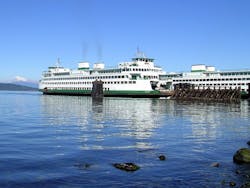Washington State Cooperative Installs First of Many Microgrids Planned for Islands
Orcas Power & Light Cooperative (OPALCO) has set up a 500-kW solar microgrid on Decatur Island, one of several island microgrids planned for the San Juan Islands, off the north coast of Washington.
“I consider this the first of many … to help maintain our power reliability as we transition away from carbon based fuels,” Foster Hildreth, OPALCO general manager, said Feb. 24 during a presentation on the project.
The Decatur Island microgrid, which started operating in February, includes a 1-MW, 2.6-MWh lithium iron phosphate battery storage system that can supply the island’s 500 homes with power for about four hours. The batteries are next to a community solar project, which started operating in 2018.
The project will allow OPALCO to defer undersea transmission investments and reduce peak load, which will extend the life of electric equipment while reducing peak charges from the Bonneville Power Administration, supplier of the island’s electricity, according to Russell Guerry, OPALCO manager of engineering and operations.
The savings from the project, plus a $1 million grant from the state, will more than pay for the microgrid, he said.
The microgrid installation will provide local energy that can smooth out variations in the power supply from the mainland, according to Imre Gyuk, director of energy storage at the Department of Energy’s (DOE) Office of Electricity.
The DOE’s Pacific Northwest National Laboratory (PNNL) will monitor the facility for the next few years, analyzing its technical and economic performance, Gyuk said.
“While we will always be tied to the mainland power, for our lives in San Juan County, this microgrid and the ones to follow will decrease our dependency on the mainland power and give us more control of our local power,” said Suzanne Olson, OPALCO’s public relations administrator.
“I consider it one step for an island and one giant leap for personkind.” — Washington Gov. Jay Inslee
More island microgrids coming
OPALCO, which serves about 15,150 electric meters, plans to build microgrids near all the villages in its service territory where essential services are located. The cooperative utility, which has 20 islands in its service territory, aims to have enough battery capacity to serve Washington’s ferries, which are being converted to a hybrid-electric fleet.
“Our goal is to put more and more microgrids on the system,” Hildreth said. “The more microgrids that we can integrate into our system, the more power we’re going to have for emergency services.” He added that the utility will be able to reroute that power around to the essential facilities and critical infrastructure in the community.
Power outages cost the San Juan Islands about $3.5 million a year, according to OPALCO’s long range plan, which envisions seven utility microgrids by 2040.
The utility is preparing to install a microgrid on San Juan Island. The utility’s 2021 budget, approved in November, includes funds to set up a 2-MW/4-MWh battery storage system to go with a community solar array.
The project will cover at least 3.8 acres, but its exact size will depend on the permitting process, according to Guerry.
OPALCO expects to receive state financial support for the project.
Microgrid model for other US communities
The Decatur Island project is a model for communities across the United States, according to the DOE’s Gyuk.
“Decatur will become a model for islands and remote communities throughout the United States,” Gyuk said.
Data from the Decatur project collected by the PNNL was used to help Nantucket Island, off the coast of Massachusetts, decide to install an aggregated 6-MW, 48-MWh battery storage system to reduce peak load and forestall the need to upgrade an undersea cable, Gyuk said.
The Decatur project shows that microgrids are a viable option for other parts of Washington, according to Washington Gov. Jay Inslee.
“I consider it one small step for an island and one giant leap for personkind,” Inslee said. “It really is thrilling to see people really taking control of their own destiny in a way that’s meaningful, that’s going to be good for their personal lives, have more sustainable secure power, don’t have to worry about that cable going out so much, but also … decarbonizing our system.”
The Decatur project shows how renewable energy can be effective in small, rural communities, Inslee said.
Learn more about microgrids. Join us for Microgrid 2021: The World Awakens to Microgrids, a virtual conference that begins May 11. Important note: Advance registration is free but capacity is limited, so please register soon.
